Coronavirus: Australia still faces $400b hit as zero cases in four states
The Australian economy could take a $400 billion hit if restrictions continue for six months, as four states recorded no new cases in the past 24 hours. The COVIDSafe app is proving to be popular, but Barnaby Joyce has still rejected it.
Coronavirus
Don't miss out on the headlines from Coronavirus. Followed categories will be added to My News.
Spain lets kids play outside for first time in six weeks
Cuomo ‘wants to reimagine, not just reopen’ New York
Coronavirus numbers across Europe fall to lowest levels in a month
More than 1.13 million Aussies download COVIDSafe app
The Australian economy could take a $400 billion hit if restrictions adopted to fight the coronavirus continue for six months.
New modelling by the Business Council of Australia shows the gross domestic product impact on the economy would be $402.6 billion, or 20.7 per cent, in calendar 2020 if a longer-term “U-shaped” recovery option was implemented.
This compared to a $197.3 billion loss with a one month “V-shaped” recovery plan, or a $278.3 billion loss if a three-month “V-shaped” recovery was implemented.
Queensland and Western Australia will begin easing some restrictions from this week, while category two and some category three elective surgeries will recommence from Monday.
It includes IVF, dental work, screening programs, all child surgeries, joint replacements, eye procedures, endoscopies and colonoscopies.
Elective surgeries were postponed last month to free up beds and save personal protective equipment amid fears the coronavirus would overwhelm the hospital system.
Australian Medical Association president Tony Bartone welcomed the gradual return to elective surgery while lending his support to the COVIDSafe app.
“(Elective surgery) is an important additional component in ensuring that we deal with the necessary burden of disease now, and do not defer and roll out a significant hump of unexpected complications in managing those conditions as we reach the end of COVID-19,” he said.
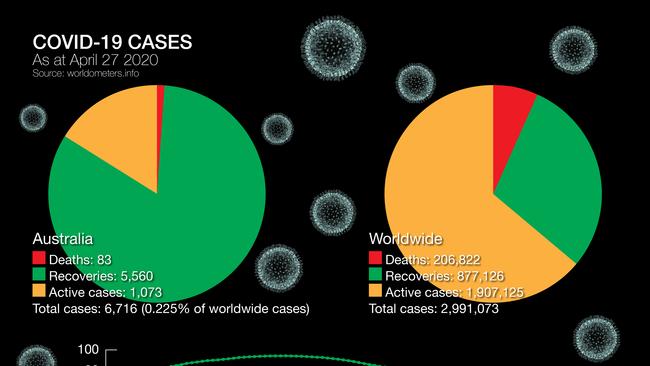
Dr Bartone also urged Australians not to neglect their health concerns, following widespread reports people were avoiding seeing their doctor amid fears of contracting coronavirus.
“Heart attacks, strokes, diabetes, cancers do not take a holiday because of the circulating COVID-19 virus and the message to Australians is to continue their usual care and see a doctor for whatever symptoms are unusual,” he said.
“Don’t write it off. It might be your health that you are putting off.”
Australia has also continued to flatten the curve with no new cases reported in four states in the past 24 hours.
There were just eight new cases in NSW since Friday night and even less in Queensland and Victoria.
Western Australia, South Australia, the Australian Capital Territory and Northern Territory had zero new cases.
The development came as 1.13 million Australians downloaded and registered for the COVID-19 contact tracing app COVIDSafe within 12 hours of registrations opening Sunday.
Health Minister Greg Hunt tweeted the figures late last night, again urging people to download the app.
The Bluetooth-enabled technology platform was launched for Apple and Android phones, with registrations opening at 6pm (AEST).
The app identifies people who may have come into contact with someone who has COVID-19 so that they can be advised to take measures to help stop the spread of the disease or get tested.
But there is one button on the tracing app causing alarm for users.
Clicking ‘Upload My Information’ tells users they have tested positive to COVID-19.
In fact, the button should only be pressed if advised by a health professional.

Meanwhile, outspoken Nationals MP Barnaby Joyce is refusing to download the app citing privacy concerns.
“I live in an area where all the time we have things hacked,” he told Seven’s Sunrise today.
“I don’t know whether if at the end of it if they remove the references or the total files.
“This is a free country and I make it my free choice not to do it”.
He added this app will not stop people from getting COVID-19
“How is it going to stop people from mingling?,” he said.
That prompted Opposition Agriculture and Resources Minister Joel Fitzgibbon to quickly reply “Yes it will”.
Mr Fitzgibbon said he downloaded the app and encouraged others to join.
“Ill do anything reasonable to help further stop the spread of the virus, to get our lives back to some normality and to get the economy moving again,” he said.
“There is a risk in crossing the road but I’ll cross the road to get myself a feed, we need critical mass … otherwise we are all wasting our time.”
KIDS LET OUT TO PLAY IN SPAIN
Spain’s government lifted a home confinement rule for children under 14 years old after 44 days in seclusion on Sunday (local time), ending one of the most restrictive measures of its national lockdown to rein in a coronavirus outbreak that has claimed over 22,000 lives in the European country.
Even Italy, with more deaths than Spain, has not kept its youngsters completely secluded.
Indeed, in Spain, the streets echoed again with children’s shrieks of joy and the clatter of bicycles.

Children were allowed out with one parent for up to an hour, as long as they stayed within one kilometre of their homes, took only one toy and did not play with other youngsters.
“This is wonderful! I can’t believe it has been six weeks,” Susana Sabate, the mother of three-year-old twin boys, said in Barcelona.
“My boys are very active. Today when they saw the front door and we gave them their scooters, they were thrilled.”

Ms Sabate’s sons wore child-size face masks as they went out.
She said they were used to seeing both their parents wear them when they went out, so she believed that made it easier to convince them to put them on.
“We will see how long they last!” she said.
Spanish Prime Minister Pedro Sanchez will present a detailed plan on Tuesday for the “de-escalation” of Spain’s lockdown.
His French counterpart likewise said he will unveil a “national deconfinement strategy” on the same day.
“Maximum caution will be our guideline for the rollback,” Mr Sanchez said.
“We must be very prudent, because there is no manual, no road map, to follow.”
Italy’s Premier Giuseppe Conte is expected to announce more details on easing the lockdown there in the coming days.
Mr Conte said priorities include restarting construction projects and export industries.
He confirmed that school classes won’t resume until September.
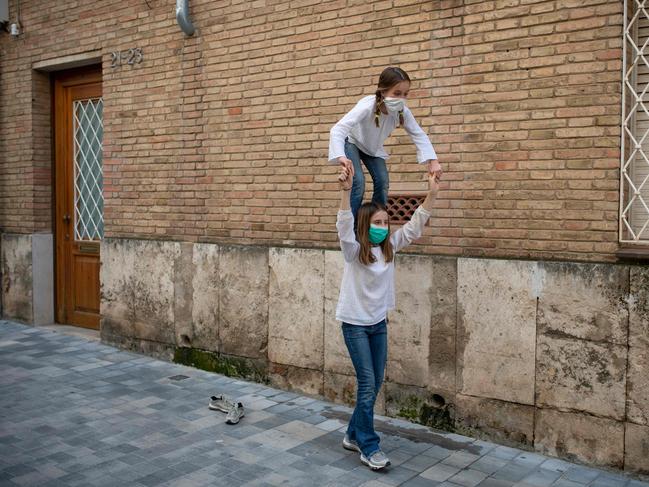
Other European nations are further along in easing lockdowns.
Germany allowed non-essential shops and other facilities to open last week, and Denmark has reopened schools for children up to grade five.

Meanwhile in Wuhan, the Chinese city where the global coronavirus pandemic began, now has no remaining cases in its hospitals, a health official has told reporters.
It comes as all major construction projects resumed as authorities pushed to restart factory production and other economic activity after a two-and-a-half-month lockdown.
“The latest news is that by April 26, the number of new coronavirus patients in Wuhan was at zero, thanks to the joint efforts of Wuhan and medical staff from around the country,” National Health Commission spokesman Mi Feng said at a briefing on Sunday.
The city had reported 46,452 cases, 56 per cent of the national total. It saw 3869 fatalities, or 84 per cent of China’s total.
SPAIN’S TOLL ‘LOWEST IN A MONTH’
Meanwhile, Spain’s daily coronavirus death toll dropped to 288, the lowest since March 20, as the country eased its lockdown to allow children outside for the first time in six weeks.
It comes as European countries methodically worked to ease their lockdowns and reopen their economies, while in the United States, governors moved at differing speeds, some more aggressive, others more cautious.
Elsewhere around the world, governors in states like hard-hit New York and Michigan are keeping stay-at-home restrictions in place until at least mid-May, their counterparts in Georgia and Oklahoma have allowed salons, spas and barber shops to reopen.
And Alaska cleared the way for restaurants to resume dine-in service and for stores and other businesses to open, with limitations.

The official death toll from the virus topped 200,000 worldwide, with 2.9 million confirmed infections, according to a tally by Johns Hopkins University in the US, though the real figures are believed to be much higher, in part because of inadequate testing and differences in counting the dead.
Italy, Britain, Spain and France accounted for more than 20,000 deaths each, the US for more than 55,000.
Some encouraging signs were seen, as Italy recorded its lowest 24-hour number of deaths since mid-March, with 260, and New York State registered its fewest since late last month,
with 367.

JOHNSON BACK AT DOWNING STREET
In Britain, as Boris Johnson returned to work he faced calls for more clarity on when his government will ease the lockdown, now set to run until at least May 7.
Mr Johnson was back in his London office at 10 Downing Street on Sunday (local time), Sky News said.
The UK prime minister spent a week in hospital with COVID-19 and two weeks recovering at his country residence.
A Downing St spokeswoman declined to comment on Mr Johnson’s whereabouts.
The government had previously announced Mr Johnson would be back at work on Monday. Foreign Secretary Dominic Raab, who has been deputising for him in his absence, said Johnson was “raring to go”.

In his last day standing in for Mr Johnson, Raab said it would not be responsible to speculate about the details of how the lockdown would be relaxed as that risked diluting the message that people should stay at home.
“We are at a delicate and dangerous stage and we need to make sure that the next steps are sure-footed,” Mr Raab said on Sky News.
The official number of deaths related to COVID-19 in hospitals across the UK rose to 20,732, up by 413 in 24 hours.
Confirmed cases stood at 152,840, up by 4463 on the previous day, the latest figures showed.
More comprehensive but lagging figures that include deaths in the community, such as in nursing homes, suggest the overall toll is likely to be significantly higher than the hospital
number.
“We are proceeding very cautiously and we are sticking to the medical advice, the scientific advice, with the social distancing measures, at this time, while doing all the homework to make sure that we’re prepared in due course for the next phase,” Mr Raab said.

Repeatedly pressed for details, he would say only that there would not be a “binary easing of measures” but rather a gradual progression to a “new normal”. Later, at the government’s televised daily briefing, farming and environment minister George Eustice said the lockdown rules would next be reviewed “in a couple of weeks” in light of the medical evidence available by then. National Health Service medical director Stephen Powis said during the briefing there was now a “very definite” downward trend in the number of people in hospital with COVID-19.
“That is definitely showing that our compliance with social distancing is proving to be beneficial, it is reducing the transmission and spread of the virus,” he said.
Opposition Labour Party leader Keir Starmer argued in an open letter to Mr Johnson that the British government was falling behind the rest of the world by refusing to say more about the next steps, and it should treat the public like adults. “Simply acting as if this discussion is not happening is not credible,” Mr Starmer wrote in the letter, which he tweeted on Sunday.

NYC COULD ‘PARTIALLY RE-OPEN’ ON MAY 15
New York, which has ground to a halt to stop the coronavirus pandemic, may start reopening manufacturing and construction after May 15, Governor Andrew Cuomo said on Sunday (local time).
Gov. Cuomo, however, said that any easing of measures would take place first in the north of the state and not in the New York City metropolitan region, by far the hardest-hit area in the United States.
“The regions that would be more likely able to open sooner would be the upstate regions,” Gov. Cuomo told reporters. “Downstate New York is going to be more complicated.”
He said that any potential reopening of New York City, the country’s most populous city, could need to be co-ordinated with authorities in the adjacent states of New Jersey and Connecticut.
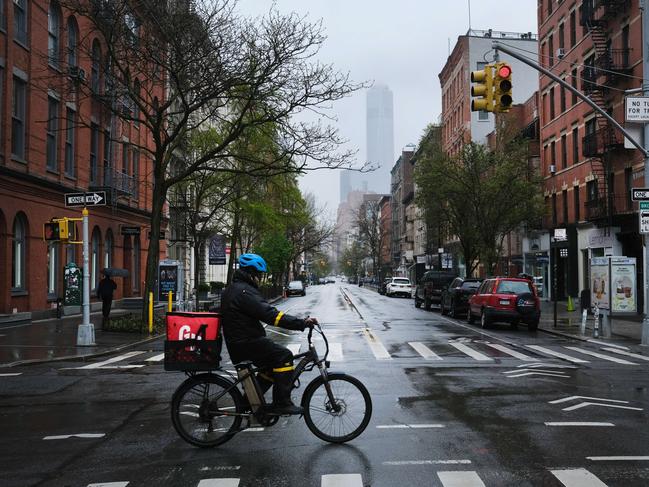
A lockdown of New York ordered by Gov. Cuomo is set to expire on May 15. Under a plan for reopening, the first sectors would be construction and manufacturing.
Gov. Cuomo said the state was operating with a caveat — “don’t do anything that’s going to bring people in from all across the board.”
Gov. Cuomo has called for a two-week delay before the next stage of reopenings, which would include most offices, to ensure that the first phase does not trigger a resurgence of the virus.
The governor stressed that any final decision would be conditioned on a downturn in COVID-19 hospitalisations between now and May 15.
The state on Sunday reported 367 fatalities in the previous 24 hours, the lowest number since March 30 when 332 people died.
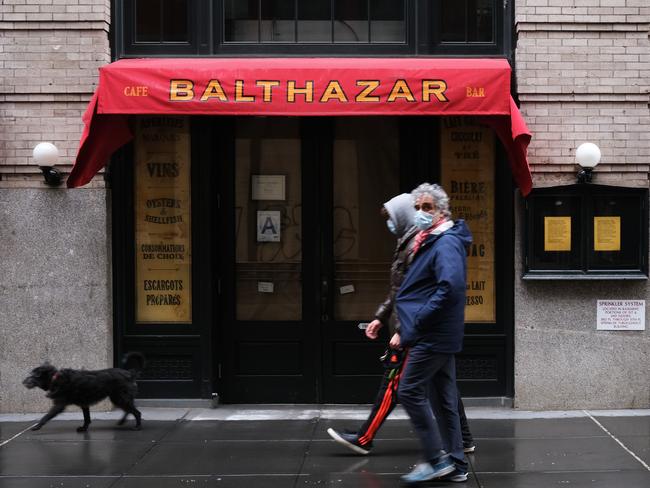
COVID-19 has now killed 16,966 people in New York State, accounting for around a third of the deaths in the United States.
To reopen, businesses will need to present New York authorities with plans that show they are ensuring sanitation to reduce the risk of virus transmission.
Gov. Cuomo said that no full-scale return to normal could come until the reopening of schools, which would allow parents to work outside of home.
New York State has not made a decision on reopening the education system, although Mayor Bill de Blasio has said that he considers the rest of the school year cancelled in the city.
Gov. Cuomo said that some school districts were studying whether to hold summer sessions to make up for lost time.
Still, Gov. Cuomo sounded a cautious note about any reopening, though he acknowledged officials need to think about safe activities people can engage in as the crisis wears on.
“You can’t tell people in a dense urban environment all through the summer months: ‘We don’t have anything for you to do,”’ Gov. Cuomo said.
“There’s a sanity equation we need to pay attention to.”
Oklahoma Governor Kevin Stitt said that with hospitalisations dropping in his state, it will reopen churches and restaurant dining on Friday, with social distancing guidelines in place.
“We believe it’s the time to have a measured reopening,” he told Fox News.

Michigan Governor Gretchen Whitmer told ABC News in the US that her state needs more robust testing, community tracing and a plan for isolating people who get sick with COVID-19.
“We’ve got to be nimble and we have to follow the science and be really smart about how we re-engage,” she said, “because no one — no one, even if you’re a protester or you’re the sitting governor or you’re on another side of the issue — we know that no one wants a second wave.”
She added: “It would be devastating for the health of our people and for our economy.”
As some states began considering loosening restrictions on churches, one Louisiana pastor already under house arrest for holding mass gatherings conducted a service Sunday despite the state’s ban on gatherings of more than 10 people.
A livestream from the Life Tabernacle Church in the town of Center showed Tony Spell walking among more than 100 congregants, most of whom were not wearing face masks.
“Shouldn’t nobody be scared right now but the devil,” he said, adding: “God gave you an immune system to kill that virus.”
With infections and deaths easing in three of the hardest-hit spots in Europe, people in Italy, France and Spain were eager to hear their leaders’ plans for easing some of the world’s strictest lockdowns.
MEDICAL PROFESSIONALS BACK COVID-19 APP
Medical professionals have been quick to back the Morrison government’s COVID-19 tracer app, which aims to help health officials identify people who may have come into contact with someone with the disease.
Called COVIDSafe, the voluntary app became available for download and registration on Sunday.
“It assists in the early alert and finding of people who may have been in contact with a person who is positive with a diagnosis,” Mr Hunt told reporters as he announced the launch of the app in Canberra.
The app is based on Singapore’s Tracetogether software, which records the Bluetooth connections a phone makes with others so the user can give that data to state health authorities if they catch the virus.
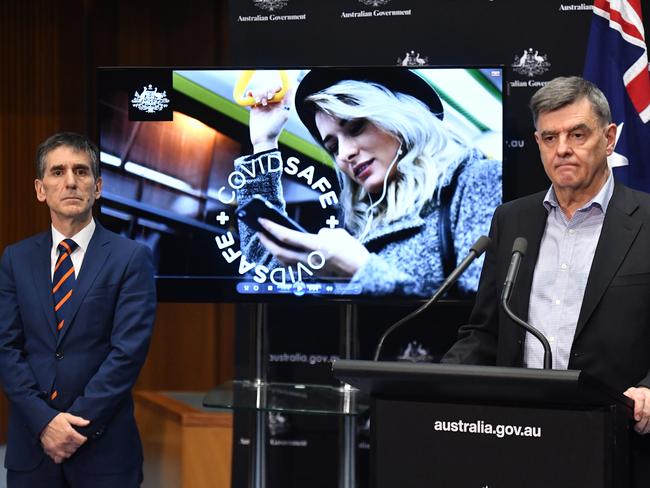
The government hopes a broader testing regimen and the contact tracing app will lead to a relaxation of the economic shutdown sooner.
Prime Minister Scott Morrison told ABC radio that only health authorities would have access to the data.
“It’s another tool we need to get back to normal as much as we can,” he said.
He said the contact numbers picked up by a person’s phone are only downloaded by a health officer when someone gets the coronavirus and gives permission. “No other government agency can use this information, no one in the commonwealth government at all, and in state authorities, only the health officer can use it,” he said.
“Not the police, not the welfare people, nowhere else. Just the health officer.”
Australian Privacy Commissioner Angelene Falk said important safeguards were in place to protect personal information collected via the app, and her office would watch its implementation closely.
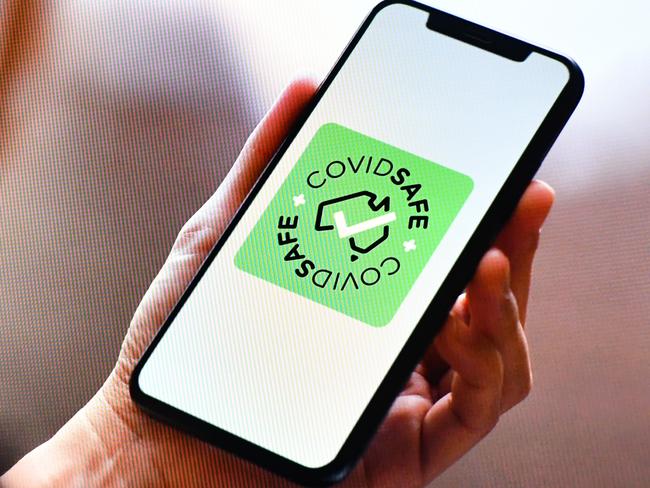
“We can audit the system and investigate complaints from the public about privacy issues,” the commissioner said in a statement on Sunday. Labor health spokesman Chris Bowen said the app had been activated under the Biosecurity Act as an interim measure, but expects it will be legislated when parliament sits in mid-May and that will be important to assure Australians of their privacy.
“I’d be happy to download the app,” Mr Bowen told reporters in Sydney. “The only people I’ve seen say that they won’t download the app are Liberal and National MPs.” Australian Medical Association President Tony Bartone said the app was an important part of Australia’s response to the pandemic.
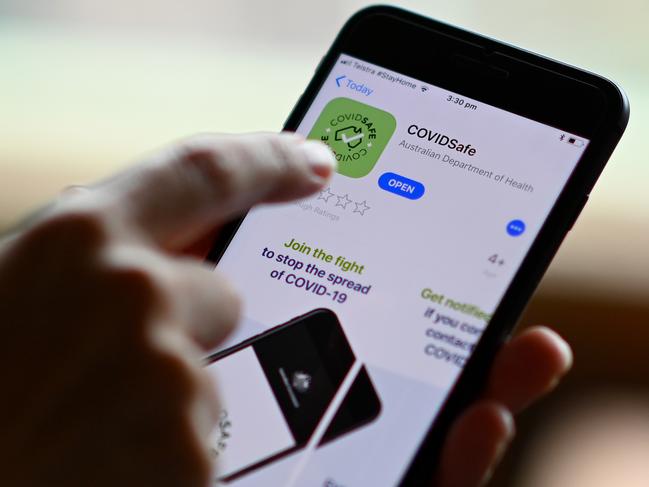
“The COVID-19 COVIDSafe app will assist in the contact tracing process, that laborious slow process which, together with the marvellous community response, has been implicitly responsible for reducing the spread of COVID-19 in the community and flattening the curve,” Dr Bartone said.
Business Council of Australia chief executive Jennifer Westacott urged all Australians to download the app.
“The more Australians who download the app the safer we will all be and the more quickly we can begin to ease restrictions,” she said in a statement.
Research from the Australia Institute shows 45 per cent of Australians say they will download and use the mobile app, while 28 per cent say they won’t. A further 27 per cent were unsure.
